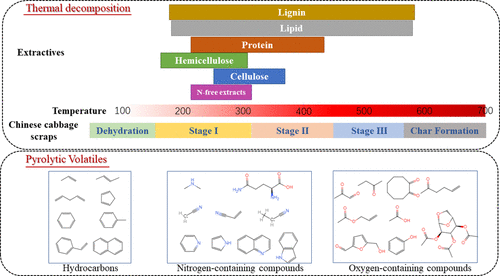当前位置:
X-MOL 学术
›
Energy Fuels
›
论文详情
Our official English website, www.x-mol.net, welcomes your feedback! (Note: you will need to create a separate account there.)
Valorization of Vegetable Waste via Pyrolysis: Thermal Behavior, Volatiles Release, and Products Analysis from Its Extractives
Energy & Fuels ( IF 5.3 ) Pub Date : 2020-01-21 , DOI: 10.1021/acs.energyfuels.9b03970 Yingyun Qiao 1, 2 , Fanfan Xu 1, 3 , Xue Ming 1 , Shangwu Feng 4 , Yaoyao Ji 1 , Yuan Jiang 1 , Jun Li 1 , Bo Wang 5 , Yuanyu Tian 1, 2
Energy & Fuels ( IF 5.3 ) Pub Date : 2020-01-21 , DOI: 10.1021/acs.energyfuels.9b03970 Yingyun Qiao 1, 2 , Fanfan Xu 1, 3 , Xue Ming 1 , Shangwu Feng 4 , Yaoyao Ji 1 , Yuan Jiang 1 , Jun Li 1 , Bo Wang 5 , Yuanyu Tian 1, 2
Affiliation

|
There is a recognized need for cleaning the disposal of food scraps to maximize waste-to-energy conversion. The principal objective of this investigation was to carry out an in-depth analysis of the pyrolysis of Chinese cabbage scraps from the perspective of chemical group composition. First, a modified separation method for chemical group composition from feedstock was established, and the physicochemical properties had proved the bioenergy potential of Chinese cabbage scraps. Then, thermal decomposition and typical functional groups’ release characteristics were determined using a thermogravimetric Fourier transform infrared spectrometer. The results showed that the pyrolysis behaviors of different extractives were not the same and the pyrolysis process of Chinese cabbage scraps can be divided into five stages. The release characteristics of typical gaseous products and functional groups of Chinese cabbage scraps and their extractives were roughly consistent with the pyrolysis temperature interval. Finally, the specific pyrolytic volatiles information was detected and analyzed by pyrolyzer-gas chromatography/mass spectrometry, which can be summarized as hydrocarbons, nitrogen-containing compounds, and oxygen-containing compounds. Furthermore, the possible formation pathway of different types of compounds was also inferred.
中文翻译:

通过热解对蔬菜废料进行增值:热行为,挥发物释放及其提取物中的产物分析
公认需要清洁食物残渣的处置以最大程度地将废物转化为能量。这项研究的主要目的是从化学基团组成的角度对大白菜碎料的热解进行深入分析。首先,建立了一种从原料中分离化学基团组成的改进方法,其理化性质证明了大白菜碎屑的生物能潜力。然后,使用热重傅里叶变换红外光谱仪测定热分解和典型官能团的释放特性。结果表明,不同提取物的热解行为不同,大白菜残渣的热解过程可分为五个阶段。大白菜残渣及其提取物的典型气态产物和官能团的释放特性与热解温度区间基本一致。最后,通过热解气相色谱/质谱法检测和分析了特定的热解挥发物信息,这些信息可以概括为碳氢化合物,含氮化合物和含氧化合物。此外,还推测了不同类型化合物的可能形成途径。含氮化合物和含氧化合物。此外,还推测了不同类型化合物的可能形成途径。含氮化合物和含氧化合物。此外,还推测了不同类型化合物的可能形成途径。
更新日期:2020-01-22
中文翻译:

通过热解对蔬菜废料进行增值:热行为,挥发物释放及其提取物中的产物分析
公认需要清洁食物残渣的处置以最大程度地将废物转化为能量。这项研究的主要目的是从化学基团组成的角度对大白菜碎料的热解进行深入分析。首先,建立了一种从原料中分离化学基团组成的改进方法,其理化性质证明了大白菜碎屑的生物能潜力。然后,使用热重傅里叶变换红外光谱仪测定热分解和典型官能团的释放特性。结果表明,不同提取物的热解行为不同,大白菜残渣的热解过程可分为五个阶段。大白菜残渣及其提取物的典型气态产物和官能团的释放特性与热解温度区间基本一致。最后,通过热解气相色谱/质谱法检测和分析了特定的热解挥发物信息,这些信息可以概括为碳氢化合物,含氮化合物和含氧化合物。此外,还推测了不同类型化合物的可能形成途径。含氮化合物和含氧化合物。此外,还推测了不同类型化合物的可能形成途径。含氮化合物和含氧化合物。此外,还推测了不同类型化合物的可能形成途径。



























 京公网安备 11010802027423号
京公网安备 11010802027423号